“Going wide” is a hostile issue for indies. It’s somewhere up there with the duke-it-out debate on plotting vs pantsing and the never-ending fight over show vs tell. For me, going wide was a no-brainer once a much-more-successful indie friend said, “Garry, you’re leaving a lot of money on the table by remaining exclusive on Amazon.”
So it was that last year, in the year whose name shall not be mentioned, I took the leap of faith and published my ebooks on Kobo and Nook. (Best damn book business decision I ever made.) I’m still with Amazon, though, and I freely admit I still make the most money letting the Zon pimp me out. However, Kobo is great, simple to use, and gives me a wider exposure than AZ. I’ve had Kobo downloads in 66 different countries. Nook, on the other hand, is barely worth the bother.
I couldn’t go wide on Apple until recently. That’s because I’m a PC guy and Apple publishing was exclusive to Mac users. That changed when Apple completely remodeled their ebook and audio book store and opened its Apple Books For Authors membership to PCers.
I bit into the Apple platform over the last few weeks and moved 8 publications in my based-on-true-crime series over to Apple Books. They’re now up and available if anyone wants to take a look. Publishing on Apple took a bit of time and, from the stats so far, seems to be worth it. But… there are a few things I’ve learned about Apple that I wish someone would have told me at the start. Hopefully this post will help someone who wants to know how to easily publish on Apple Books.

The Big Difference Between Apple Books and the Other E-Tailers
I’m probably like you in that I research things before I take them on. Publishing on Apple Books was no different than any other new venture, so I did my diligent homework before the dive. I read some blogs, watched a few videos, and took an Apple-sponsored webinar hosted on Alli – the Alliance of Independent Authors. All good stuff, but all failed to explain the big difference between Apple Books and the other e-tailers. And I had to find out a vital secret — the hard way.
Before exposing this vital secret, let me point you to a few good Apple Books publishing resources. First, go right through the Apple Books For Authors website and absorb it. It’ll take a while. There’s a lot there, but you’ll be poorly equipped for the trip unless you do so.
Second, check out these helpful articles:
David Gaughran — https://davidgaughran.com/apple-books-for-authors-launches-pc/
Reedsy — https://blog.reedsy.com/how-to-publish-on-apple-books/
Written Word Media — https://www.writtenwordmedia.com/how-to-self-publish-on-apple-books/
So these links, plus the info in this post, should get you onto Apple Books as smoothly and painlessly as possible. Something nobody tells you (the big difference between Apple Books For Authors and the other e-tailers) is that Apple has two separate publishing interfaces. Unlike Amazon, Kobo, and Nook, Apple has Apple Books For Authors as the mechanical part of publishing (uploading files, covers, metadata, etc.) and iTunes Connect as the financial end (setting up an account, setting prices, stores, tracking stats, getting paid, etc.).
Now for the hidden vital secret. There’s a glitch in the iTunes Connect interface that defies all logic and common sense. However, it’s there and if you don’t know about it, ITunes Connect won’t let you go forward with the Apple Books publishing side. Basically, you’re screwed unless you know the trick.
Once I found this out and cleared the incredibly frustrating roadblock apparently intentionally set-up to peeve-off a poor person like me, it was clear driving all the way to the Apple Store. Here’s a step-by-step hand-hold with applicable screenshots on how to easily publish on Apple Books. And a story to go with it.
Step 1 — Deal with iTunes Connect
Create an iTunes Connect account (if you don’t already have one). I didn’t have one because I don’t have a Mac device. BTW, the Alli webinar reported there are 1.5 billion Apple devices worldwide so you can imagine the depth of the Apple Books market.
Now the trouble started. Dave Gaughran said the iTunes Connect interface was “a bit clunky”. For me, it was a rattletrap. Simple things like entering your username (my email address) and my password were seamless. So was declaring myself as an individual as opposed to an organization. I clicked Accept on the Terms Of Service without reading them. Seriously, does anyone other than a Philadelphia lawyer ever read all that BS?
I moved on to the Complete The Agreement part. Here was the tax section which took a bit of figuring out but I struggled though it by telling the IRS that I was Canadian and to go talk to Revenue Canada about bloodsucking matters. They bought it and I made it to the next iTunes Connect round called Add New Bank Account.
It’ll be easy, they said. Just enter your chosen currency (Tip—enter USD because it’s going to make it easier when you get through this part, sent over to Apple Books Publishing, and then get rerouted back to iTunes Connect to list your ebook pricing and the countries you’re selling to. Whatever country you bank in will have its own par-value to the United States Dollar and will do the current currency exchange. Trust me on this. Do your Apple business in USD.
Then you enter your banking institution name. For me, it’s TD (Toronto Dominion) Canada Trust which is a top-ten North American financial institute. Easy enough, I thought. This should be a breeze—just like entering my name here. No problem again, same with my account number, and the last step was putting in the Transit Number or what’s also called the ABA Routing Number.

I entered 92220 which is my bank’s transit/routing number. A pop-up with a large yellow exclamation mark appeared and said “The Transit Number Is Invalid”. Hokay. Let’s try this again. Same thing. “The Transit Number Is Invalid”. I got up and got my file stashed away from when I opened my TD account, blew off the dust, and checked the information. There it was in faded black and white: Transit Number 92220. I went back to my PC and told iTunes Connect on its Apple interface that I was right and they were wrong.
Once more, “The Transit Number Is Invalid”. My wife heard my cursing. Rita had five years in the banking industry back when I first met the pretty little dish so she tried troubleshooting the matter. “They might want both the transit number and the institution number,” she said. “Here. Try entering 92220 followed by 004.” I did. Once more: “The Transit Number Is Invalid”.
The pop-up had me hostage. There was no way it was letting me past this gatekeeper, and there was no way I was ever going to get paid for selling on Apple Books without iTunes Connect brokering the deal which was the whole point of this entire exercise. “I know,” I told Rita. “I’ll go down to the bank. They’ll figure this out.” So I took a screenshot of this pesky pop-up, printed it out, and walked downtown.
With luck, my favorite teller was open. I showed Amy-Beth my sorrows. She checked the transit number, institution number, the account number, and even my name. “I don’t know, Garry.” Amy-Beth smiled a sweet smile that suited her name and shook her head. “Everything is in order. You shouldn’t be having this problem.”
“Did you, like, recently change your transit and institution numbers?” I struggled for answers.
Amy–Beth smiled less. “No, Garry. We’ve been in business since 1855. We’ve had the same numbers for a hundred and sixty-six years. They’re a standard in the international banking industry. Some things never change.”
I thanked Amy-Beth for her time and walked home. Rita had a suggestion. “Why don’t you call Apple Support? You can’t be the only one who’s had this difficulty.”
Good idea. I dialed 1-800-MY-APPLE. A service rep came on. Now, I live in North America. The service rep didn’t. I speak fairly fluent English. The service rep didn’t. I knew what my problem was. The service rep didn’t. Try as I might, there was no resolving it with the service rep.
I was frustrated as hell. Rita wasn’t. She came up with another idea. “Why don’t you ask Rachel? She’s a whiz at all things technical.”
FYI, Rachel is my close indie writer friend in the UK and the one who told me I was leaving a lot of money on the table by not going wide. By my reasoning, Rachel was the reason I was in this trouble with Apple so it was her responsibility to get me out. I emailed Rachel the situation.
Rachel replied right away. (British accent) “Blimey. I remember that snafu. If I reckon right, you have to put a zero in front of the transit number and the institution number. So it has to appear as 0XXXXXYYY. Sounds crazy, doesn’t it? But that’s the secret. A silly little zero.”
I asked Rachel how she found this out. She replied, “I had the same trouble, so I called Apple Support and they immediately solved it for me. Lovely folk, those blokes at Apple they are.”
So there you have it, Kill Zoners. The vital secret. A silly little zero, and you’re through the banking information turnstile and away you go. To clarify, my transit number looked like this and it worked.
092220004
In what universe this makes sense, I don’t know. But I know I’ll never have to deal with this strangeness again, and I’m happy to say the rest of the Apple publishing experience was excellent.
Step 2 — Publish on Apple Books For Authors
To start this step, as soon as you log onto your newly-created account at Apple Books For Authors, iTunes Connect will text you a one-time, six-figure, two-step verification code. Note: This happens every time you work with Apple Books For Authors and iTunes Connect, so get used to it.
Once you’re in the Apple Books For Authors portal you’ll see a screen titled Choose How To Publish. You have three options — Submit a New Book, Update a Previously Submitted Book, and Setup a Pre-Order. Click Submit a New Book, and follow along while I upload At The Cabin which is the 8th book in my Based-On-True Crime Series.
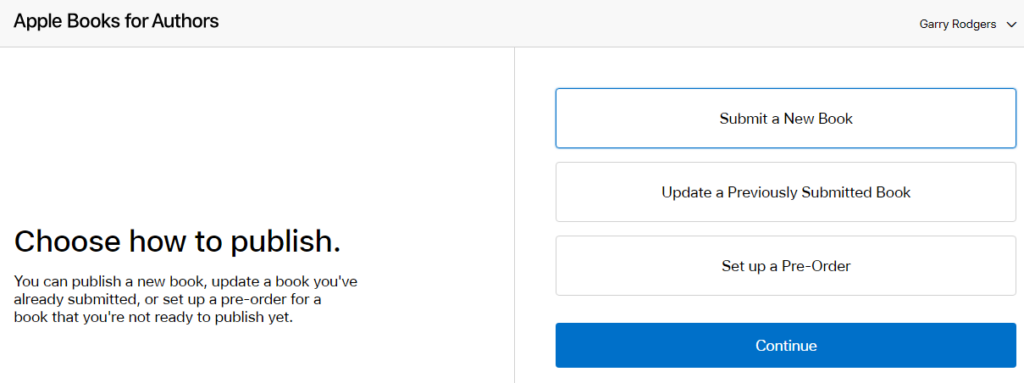
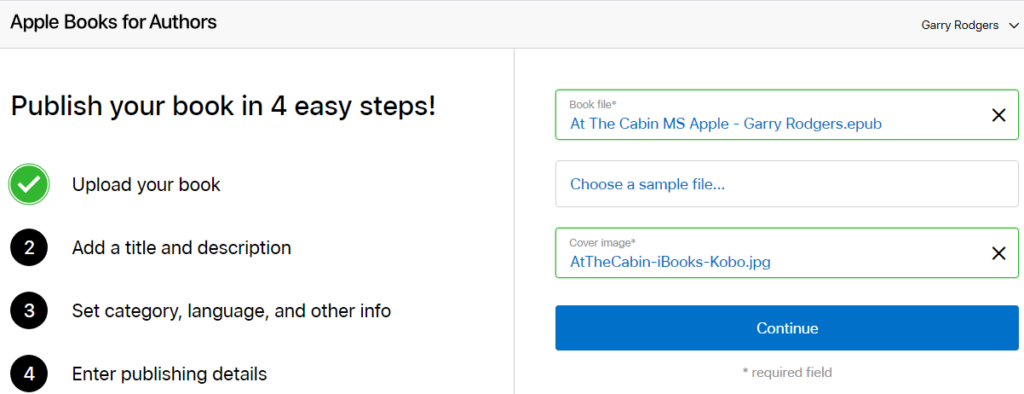
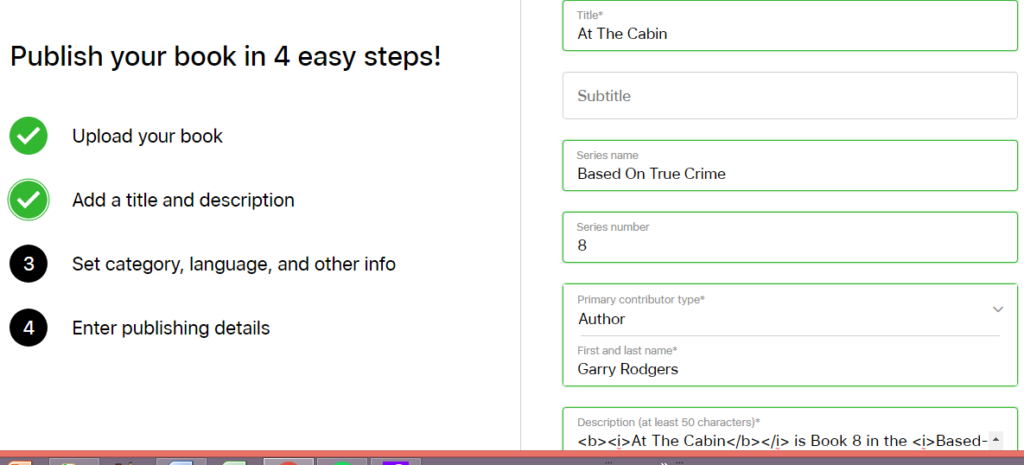
I’ve got to stop the slideshow for a sec and say something about the book description section. Writing book descriptions, jacket copy, blurbs, or whatever you call them is an art on its own. That’s for another day, but I will say that Apple’s window is a bit tight to work in. It doesn’t like paragraph spaces and will look like a picket fence in real time if you try it. Also, it doesn’t have HTML features like some of the other e-platforms do. So if you want to use bold and/or italics, you’ll have to handwrite HTML code the old fashioned way like this: <b>bold</b> & <i>italics</i>.
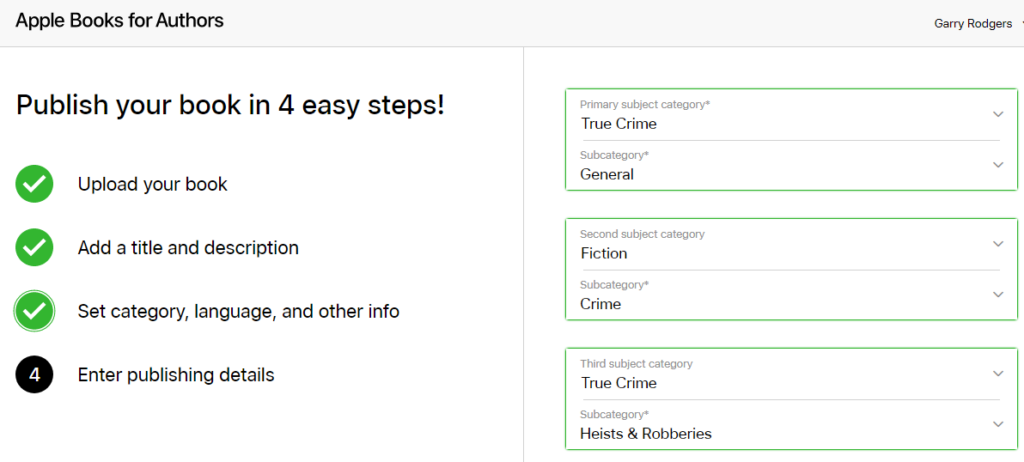

That’s it! It’s just that easy, and Apple walks you right through it. All you do now is click the blue bar Upload Book to iTunes Connect and you’re going to head back to the interface that sells your book and pays you.
I’m going to back up and cover two important points in the first step where you upload your e-file and your cover art. Apple works off an ePub file, not Mobi like Amazon’s proprietary file. I write my manuscripts in MS Word.docx and convert them to ePub files through Calibre. From my experience (over 20 publications now on four platforms) I firmly believe the key to clean productions (other than proper editing /proofreading) is to format your Word.docx file properly. I wrote a Kill Zone post titled Top Ten Tips on Formatting eBooks from MS Word. Top take-away from that is never use Tabs or even the dog won’t like your e-file for breakfast.
I see Apple has an auto-convert feature built in that bypasses a specialized e-file converting software like Calibre. I didn’t try it, but I’ve gone that route on Kindle and Kobo and wasn’t satisfied with the final product. I’m very comfortable with converting MSWord.docx to EPub and Mobi on Calibre and it only takes two minutes. If it ain’t broke, don’t fix it but you can try the built-in conversion because, one way or the other, you’ll have to upload an ePub file to Apple.
Changing the subject to covers. It’s something for an upcoming post where I’ll have my cover designer, Elle Rossi of Evernight Designs, join the Kill Zone crowd for cover lessons. Apple has a specific artwork image requirement. They want a jpeg file in size 1400 x 2100 (same as Kobo).
Step 3 — Back to iTunes Connect
I promise you – no more monkey business once you’re back on the iTunes Connect interface. Once you’re past that @#$%^& Zero thing, it’s user-friendly. Here’s what happens:
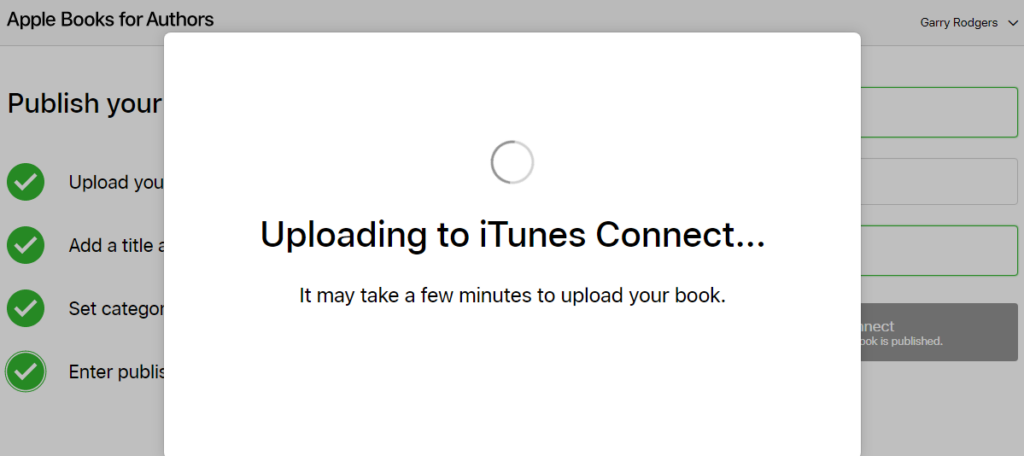

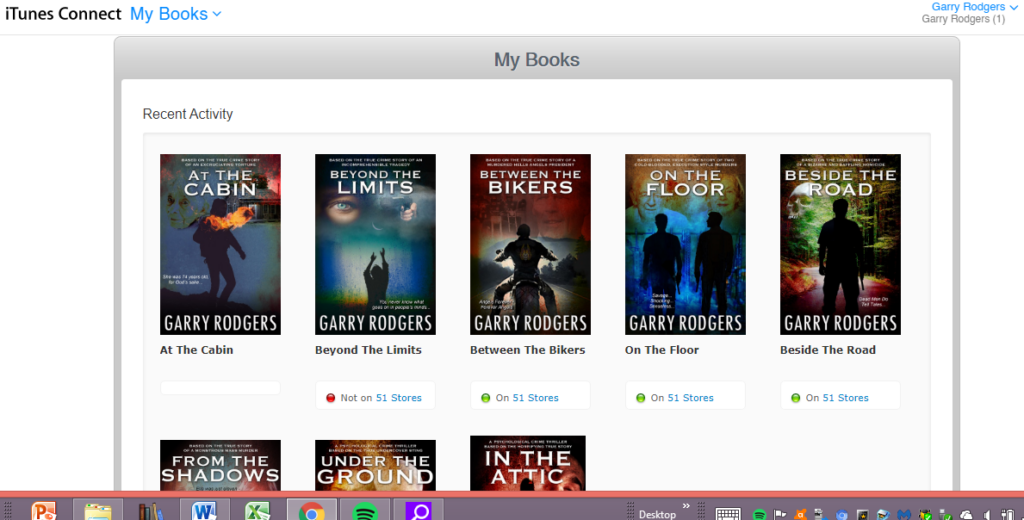
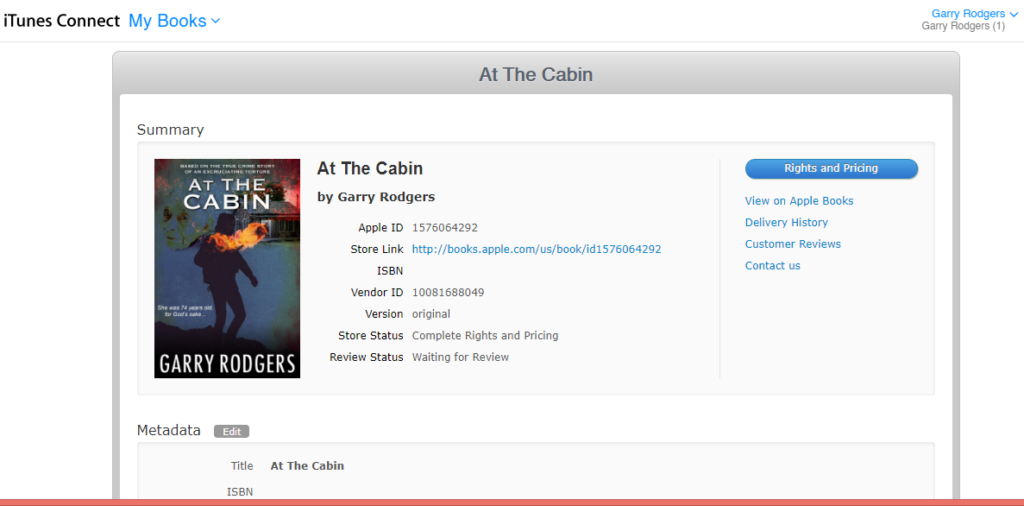
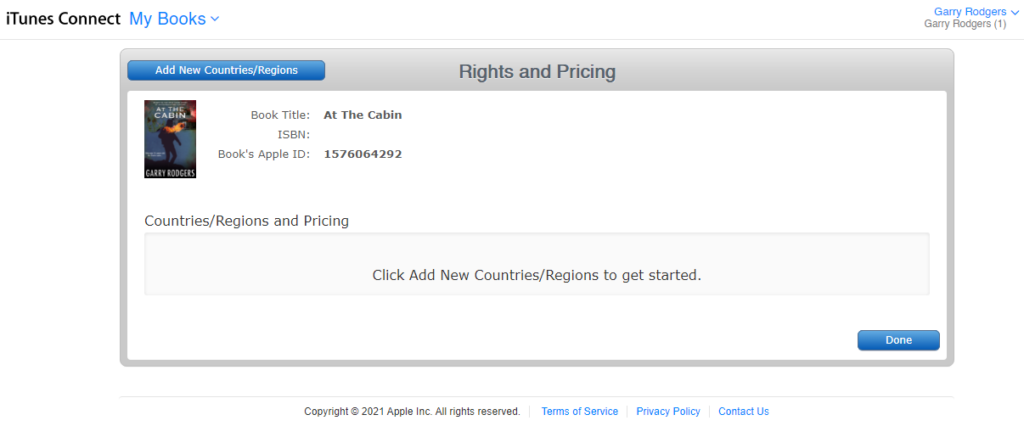
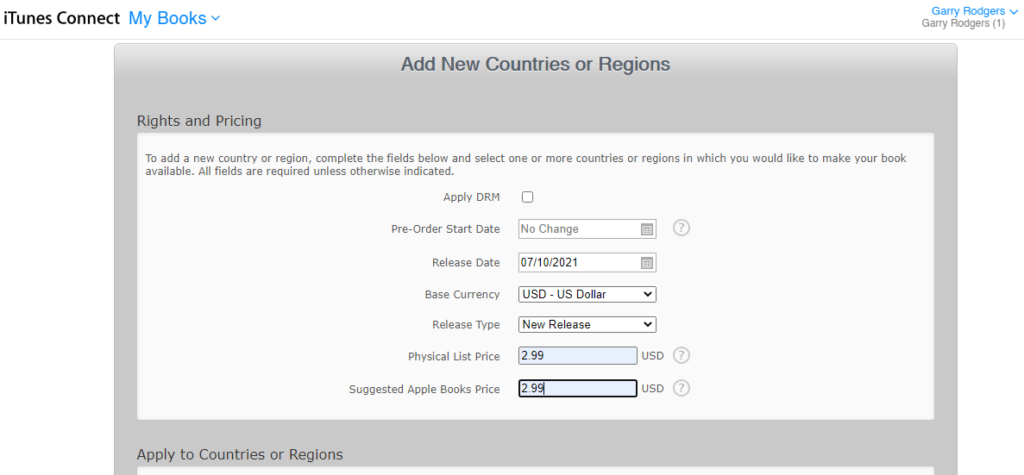
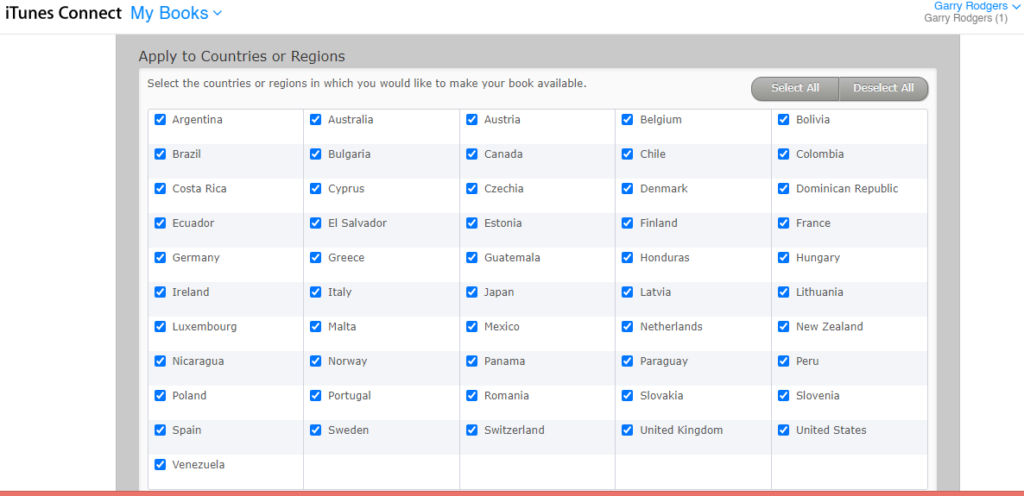
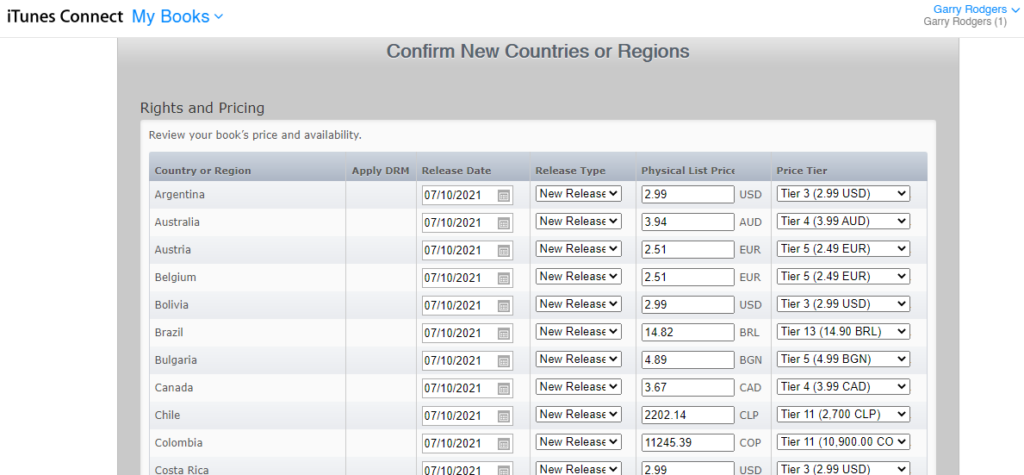
That’s it! Hit done and iTunes Connect and Apple Books For Authors will do the rest for you. It takes a few hours to a day for your new book to go live in the Apple Book Store. They’ll send you an email confirmation with the website link.
Just a few comments about completing the metadata on iTunes Connect. (Metadata is just a fancy word for information.) DRM (Digital Rights Management) is an option you have and every source I’ve ever listened to all says to leave DRM off. I don’t exactly know what it entails, but I understand by opting in you somehow limits your exposure.
Speaking of exposure, make sure you click on the Select All for Countries and Regions. Seeing as Apple currently has 51 worldwide stores, I can’t imagine why any self-respecting indie would not want to be in every store. Sidenote: Since I went wide on Kobo last year, I’ve had eBook downloads in 66 different countries. It’ll be interesting to see how Apple’s performance compares.
One final thought is on pricing. My experience is that $2.99 USD is the sweet spot for my crime genre books. But you can price anywhere up or down the scale you want, and with Apple — unlike Amazon — you don’t take a royalty beating for going below $2.99 or above $9.99.
Okay. On to pubbing on Google Play! How about you Kill Zoners? Anything you’d like to add on this or any other subject that’s on your evil minds?
———
 Garry Rodgers is a retired homicide detective and coroner. Now, Garry has reinvented himself as an indie-published crime writer whose books can be downloaded on Apple, Amazon, Kobo, and Nook. Soon they’ll be out on Google Play.
Garry Rodgers is a retired homicide detective and coroner. Now, Garry has reinvented himself as an indie-published crime writer whose books can be downloaded on Apple, Amazon, Kobo, and Nook. Soon they’ll be out on Google Play.
Vancouver Island in British Columbia is home for Garry Rodgers. Garry lives there because he’s a wuss and it’s the warmest year-round place in Canada. You can reach him at garry.rodgers@shaw.ca, at his website DyingWords.net, or on Twitter (@GarryRodgers1).

Garry.
(the above was me being speechless)
I had absolutely no interest in things Apple until reading your post this morning, which hit the sweet spot where interesting and informative when most of the ball would be dull and dense in lesser hands. I could actually see you running back and forth to the bank, as well as mightily resisting throwing your entire computer kit through the nearest window.
Thank you. I propose a parade in your honor. No social distancing.
Bering speechless is sometimes a good thing, Joe. Looking back in my life, there were times I’d have been better off speechless.
Yeah, I was really frustrated with that zero nonsense. Like, can you come up with any reason for that other than pure sadism?
Hi Garry. I have a PC, not a Mac. I publish to Amazon separately, but I used aggregator Smashwords (and later Draft2Digital) to publish my books to all the other major sellers, including Apple and including distribution to libraries. Have done since 2011.
I thought of going the aggregator route, Harvey, but I’m a control freak. I constantly go back and forth in the ePublications and make changes to links. That’s for an entire post on its own. Plus, I’m a cheap prick and don’t want to lose 15%. Enjoy your day!
Wow, Garry, another encyclopedic post. Very helpful. I’m printing this one out. And no, I don’t have anything to add, except I have a nickname suggestion for you: With all that slashing and fighting for truth and justice, instead of Zorro, we should call you Zero, the unmasked man.
Thanks for a wonderful post, and have a great day!
I’ve been called a Zero many times, Steve, so nothing new to see here. But I could use a new cape. Maybe in camo this time.
Wow, Garry. Now, I know there are those who will take you instructions and go direct to Apple. You’ve convinced me to stick with D2D for publishing to Apple. Worth their cut. One of my critique partners moved her books from D2D to most of the other channels. and Apple was her biggest headache.
I’m doing well at Nook, plus they pay 70% across the board, and pay after 1 month, not two. Haven’t done Google Play. They were screwing around with pricing and it was a nightmare to choose the price that they would discount, so it didn’t create price matching issues with Amazon. D2D stopped sending books there.
Bottom line; I’m lazy. What I decided to do very early on wasn’t broke, so I didn’t want to fix it.
Makes me wonder how D2D deals with entering their clients’ iTunes Connect “metadata”. They must have the client set up their account independently and that would lead into the same zero problem. Go figger. Some things in life don’t make sense, Terry, like yesterday when I saw a Tesla parked beside a Shell station gas pump. I even took a picture.
Cleaning the windshield?
Wide for the win!
Thanks for the iBooks details. You left no stone unturned.
‘Morning, Philip. I think if I missed anything, probably it’s not all that important. BTW, did I mention in our thread there’s an indie Facebook group “Wide For The Win”? I recently joined and there’s a lot of pub-talk happening over there.
And…this post pretty much sums up why I stay with a publisher, who does all of this for me. LOL When/if that changes, I’ll know who to call. 😉 Thanks, Garry. Hope you sell truckloads!
As Deborah Harry says, Sue, you can call me, call me anytime. 😉
Thanks Garry!
Easiest way to upload to Apple is via Vellum which outputs beautiful files for Amazon, Nook, Kobo, GoogPlay & iBooks. I have used Vellum for years & never had a file declined. Here’s how to use Vellum if you have a PC.
https://self-publishing-academy.teachable.com/courses/180455/lectures/2712691
HTH
Hi Ruth! As a cross between a Neanderthal and a Troglodyte, I’m still chiseling away on a PC tablet. I’ve heard GREAT things about Vellum and I’d heard there’s some sort of conversion app to allow PC access – I think it’s called Vellum-In-The-Cloud or something airy like that. Thanks for sharing the link! However, I’ve paid my PC-MS Word-Calibre-Amazon-Kobo-Nook-Apple initiation dues, and I’m not going to venture outside the cave until it gets light.
Wow, Garry, what an excellent step-by-step breakdown. You really take us by the hand and guide us through every treacherous pothole.
Like Terry, your experience convinced me to stick with Draft 2 Digital which is easy for non-techies and automatically does file conversions for you.
But I still enjoyed learning about the process, esp. the secret zero code.
Hey there, Debbie. I thought if I had to suffer the Apple slings and arrows, then I should take it for the team and prevent others from going through the same madness. For me, it’s too late to look into an aggregator. They’re probably like agents and traditional publishers who wouldn’t have me anyway.
Thanks for the information on the secret zero (a new book title, I am sure for someone). As a technologist, I wonder if that leading zero is for future-proofing when the routing numbers of the next generation of fintech arrive on the scene? After all, if TD and Royal, and other established banks have low, never changing routing numbers, it makes sense that at some point, the routing numbers will not need the leading zero (at least in the near future we live in). But it would be nice if they let those of us who are not in finance and banking know what we need to do. I also wonder how many authors and publishers have walked away because of that silly issue.
Crazy issue, David. I didn’t add into the story that once I learned this zero trick, I went back to Amy-Beth and told her about it. She was thoroughly puzzled and had a few of her colleagues look at this. None of them could come up with any reason why Apple – and apparently only Apple – would want to complicate a universally standard international banking procedure. And you’re right, how many self-publishers have given up on Apple because of this silly little zero.
Thank you also for mentioning The Alliance of Independent Authors. I had no idea that group existed. Just checking it out now and it looks great.
Hi Ben. As an indie, I believe belonging to Alli is like a trucker being a Teamster. Alli is worth every cent of the yearly subscription – which I renewed yesterday for $150 CDN. Highly recommend them!
A fantastic and very thorough run down of getting on Apple Books, Garry. Bravo! That’s a great resource for Indies getting books onto Apple. I moved there in late 2017. I didn’t think about the 0 problem–I wonder if it’s a US banking thing which then gets inflicted on the rest of the world?
FWIW, even as a Mac user, I find the interface clunky.
The big challenge for me with Apple is visibility and getting in-house promo, which can make a huge difference to your visibility there. I’ve had great success being accepted for in-house promotions at Kobo and Barnes and Noble, but no luck so far with Apple.
BookBub Featured deals have given my books great, if fleeting visibility on Apple, but the other promo sites have much less of an impact (my first Freebooksy with Apple back in 2017 did fantastic, but since then, it’s faded).
As I understand it, the Apple reps like to meet you personally at a conference like NINC. I’ve been told that publishing onto Apple via Draft2Digital actually makes your chances of getting that in-house promo better than if you publish direct. I’m strongly considering doing that with my upcoming mystery series.
Thanks for this terrific post!
Thanks, Dale. Marketing on Apple is totally new to me. I understand (at this time) Apple has no in-house promotion program and they rely on the self-publisher to figure out pushes for themselves. My plan is to get the products in the stores and then start another stacked promotion through the paid discount sites with links to Apple. It sure works for bumping-up sales on Kobo and Amazon. Maybe I’m doing something wrong, but Nook is a thorough dud for me. Thanks again for you always supportive comments!
What a fabulous article, Garry! If you ever decide to give up writing, I hope you’ll go into teaching. You just put together a well-organized course in one lecture.
My books are on Amazon, B&N, Kobo, and Apple. I self-published my last novel, and I uploaded to each platform. The first three were a breeze. Apple was a pain. I believe any good software system should be intuitive to the user. I tend to dive in and, needless to say, much of my experience with Apple has been disappointing. I did contact their help number at one point and the agent got me past whatever issue I was dealing with, so I give them a thumbs-up in that department.
I haven’t looked into Google Play, so I’ll be interested to hear what you have to say about that platform.
It’s definitely worth looking into GP, Kay, IMHO. They’ve revamped the interface–it’s way better than it was back in 2018. I originally got in via the now-long-gone Pronoun, but was able to move there in 2018, and deal with the weird pricing etc, which is also gone. Lately things have gone quiet for me there, but I had some great months there in the past few years.
Thank you Dale! I just put it on my to-do list.
Thank you, Kay. In a former life, I was a part-time instructor in effective police interviewing tactics. Due to Canadian politeness, we weren’t allowed to say “interrogation” or “advanced waterboarding”. I’m a big believer in sharing and that the best way of learning and retaining a subject is by teaching it to others. Enjoy your day!
Excellent post, Garry, and so thorough and detailed, as always! Very useful info for indie authors. Sharing!
And a thank-you to you, Jodie. This was written with good intentions to help others!
Detailed as always, Garry.
When I was “wide” I wanted to go to the platforms directly, like you, to keep the percentage. I counseled writers that they could do it with a little effort. But I’ve come to see not all are wired that way, and an aggregator is a good thing.
Personally, my ROI was getting out of whack vis-a-vis doing the main thing (writing). I made the move to exclusive for financial reasons…but an added benefit was simplifying my upload life.
I guess “know thyself” might be the first question for a writer considering indie to analyze.
You are like that plate spinner on the old Ed Sullivan show, Garry. What brand of coffee to you drink?
Thanks so much, Jim. I find it’s a lot of work to get established on the e-platforms – learning curve & all – but the maintenance once it’s done isn’t too bad. I’ve never seriously looked into an aggregator. Likely that 15% take, as you say, is worth it and the time is best spent on the best ROI – writing more books – and that, IME (in my experience) is where it’s at. BTW, I recently absorbed three of your books, Voice, Pulp Fiction & Making a Living as a Writer. Great material! It’s like having you right in my writing room 🙂 Marketing for Writers Who Hate Marketing is downloaded and next on the TBR list.
Wow, thanks Garry! Hope you enjoy.
Thanks for all the good info!
As soon as your banker said they’ve had their transit number for over a hundred years, I knew the answer.
Yep! It was an Apple quirk and I still have no idea why. Nice to hear you enjoyed this, JGA.
Apple might at least tell you they expect a 9 digit number, which is what 99.99% of all people have on their checks. Most people don’t bank where you bank.
Good post.
Tried, and failed, at uploading direct to Apple Books via iTunes Connect first and second time around. But haven’t given up. I’ll go at it again when current WIP is ready for showtime. The original reason I tried was that I was getting more monthly sales on Apple via an aggregator than on Amazon and — not mentioned in Gary’s very useful post — is that with Apple Books you can distribute up to 200 FREE copies of your book to potential reviewers, bloggers, etc etc etc without it impacting your normal sale price. Whereas, if you go through an aggregator you cannot distribute your book for free to Apple Books readers. Or, at least, that is what I understand.
Correction to above comment: you can actually distribute 250 FREEE copies: “Create buzz around your title by distributing up to 250 free promo codes to reviewers, bloggers, and other media contacts.” Source Apple.
That’s an excellent point about the permafree via an aggregator, Bill. I hadn’t thought of that angle, but the permafree in a series is core to a read-through sales strategy. By my reasoning, promoting a permafree would be useless for an aggregator and therefore useless to a permafree strategy. BTW, I had no price setting issues on Apple or, for that matter, any issues besides that Zero glitch.
Love your posts Garry!
Thank you, Linda. I appreciate hearing this! 🙂